How To Clear A 240 Turret Controller Malfunction
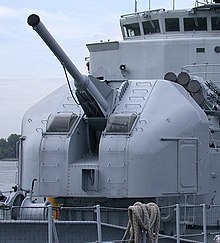
A modern naval gun turret (A French 100 mm naval gun on the Maillé-Brézé pictured) allows firing of the cannons via remote command. Loading of ammunition is too often done past automatic mechanisms.
A gun turret (or but turret) is a mounting platform from which weapons can be fired that affords protection, visibility and ability to turn and aim. A mod gun turret is by and large a rotatable weapon mount that houses the crew or machinery of a projectile-firing weapon and at the same time lets the weapon exist aimed and fired in some degree of azimuth and elevation (cone of burn down).
Description [edit]
Rotating gun turrets protect the weapon and its crew equally they rotate. When this significant of the word "turret" started being used at the beginning of the 1860s, turrets were usually cylindrical. Barbettes were an culling to turrets; with a barbette the protection was stock-still, and the weapon and crew were on a rotating platform within the barbette. In the 1890s, armoured hoods (also known as "gun houses") were added to barbettes; these rotated with the platform (hence the term "hooded barbette"). By the early 20th Century, these hoods were known as turrets. Modern warships take gun-mountings described as turrets, though the "protection" on them is limited to protection from the weather.
Rotating turrets can exist mounted on a fortified building or structure such every bit a coastal blockhouse, be part of a country battery, be mounted on a gainsay vehicle, a naval transport, or a military machine aircraft, they may be armed with one or more motorcar guns, automatic cannons, large-calibre guns, or missile launchers. They may be manned or remotely controlled and are most oft protected to some degree, if not really armoured.
The protection provided past the turret may exist against boxing damage, the weather conditions, general environment in which the weapon or its crew volition be operating. The name derives from the pre-existing noun turret, from the French "touret", diminutive of the word "tower",[1] meaning a cocky-contained protective position which is situated on peak of a fortification or defensive wall every bit opposed to rise directly from the footing, in which case it constitutes a tower.
Cupolas [edit]

A small turret, or sub-turret set on top of a larger one, is called a cupola. The term cupola is also used for a rotating turret that carries a sighting device rather than weaponry, such as that used past a tank commander.[i]
Warships [edit]
Earlier the development of large-calibre, long-range guns in the mid-19th century, the archetype battleship design[ii] used rows of gunport-mounted guns on each side of the ship, ofttimes mounted in casemates. Firepower was provided past a large number of guns, each of which could traverse only in a limited arc. Due to stability issues, fewer large (and thus heavy) guns can be carried high on a transport, but as this gear up casemates low and thus almost the waterline they were vulnerable to flooding, effectively restricted their utilize to calm seas. Additionally casemate mounts had to exist recessed into the side of a vessel to beget a wide arc of burn, and such recesses presented shot traps, compromising the integrity of armour plating.[ dubious ]
Rotating turrets were weapon mounts designed to protect the crew and mechanism of the artillery piece and with the capability of existence aimed and fired over a wide arc, typically between a 3-quarter circle up to and including a total 360 degrees. These presented the opportunity to concentrate firepower in fewer, better-sited positions by eliminating back-up, in other words combining the firepower of those guns unable to engage an enemy because they sited on the wrong beam into a more powerful, and more than versatile unified battery.[ dubious ]
History [edit]

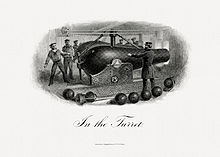
Designs for a rotating gun turret engagement back to the late 18th century.[2] In the mid 19th century, during the Crimean War, Captain Cowper Phipps Coles constructed a raft with guns protected by a 'cupola' and used the raft,[i] named the Lady Nancy, to vanquish the Russian town of Taganrog in the Black Bounding main during the Siege of Taganrog. The Lady Nancy "proved a great success"[3] and Coles patenting his rotating turret design afterwards the state of war.
UK: showtime designs [edit]
The British Admiralty ordered a paradigm of Coles'southward patented design in 1859, which was installed in the ironclad floating battery, HMS Trusty, for trials in 1861, becoming the first warship to be fitted with a revolving gun turret. Coles's aim was to create a ship with the greatest possible all round arc of burn, as low in the water as possible to minimise the target.[4]

HMS Captain was one of the first ocean-going turret ships.
The Admiralty accustomed the principle of the turret gun equally a useful innovation, and incorporated it into other new designs. Coles submitted a design for a transport having ten domed turrets each housing two large guns.
The design was rejected as impractical, although the Admiralty remained interested in turret ships and instructed its own designers to create better designs. Coles enlisted the support of Prince Albert, who wrote to the first Lord of the Admiralty, the Duke of Somerset, supporting the structure of a turret ship. In January 1862, the Admiralty agreed to construct a ship, HMS Prince Albert which had 4 turrets and a depression freeboard, intended only for coastal defence.
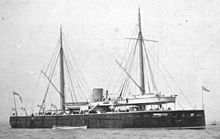
While Coles designed the turrets, the transport was the responsibility of Principal Constructor Isaac Watts.[4] Some other ship using Coles' turret designs, HMSRoyal Sovereign, was completed in August 1864. Its existing broadside guns were replaced with 4 turrets on a apartment deck and the transport was fitted with v.v inches (140 mm) of armour in a belt around the waterline.[4]
Early on ships like the Majestic Sovereign had lilliputian sea-keeping qualities beingness limited to littoral waters. Sir Edward James Reed, went on to design and build HMS Monarch, the starting time seagoing warship to carry her guns in turrets. Laid down in 1866 and completed in June 1869, it carried two turrets, although the inclusion of a forecastle and poop prevented the turret guns firing fore and aft.[5]
U.s.a.: USS Monitor [edit]

The gun turret was independently invented by the Swedish inventor John Ericsson in America, while technologically inferior to Coles'due south version.[6] Ericsson designed USSMonitor in 1861, its most prominent feature being a large cylindrical gun turret mounted amidships above the low-freeboard upper hull, also called the "raft". This extended well past the sides of the lower, more traditionally shaped hull.
A small armoured pilot house was fitted on the upper deck towards the bow; yet, its position prevented Monitor from firing her guns straight forward.[7] [iii] Like Coles'southward, one of Ericsson'due south goals in designing the ship was to present the smallest possible target to enemy gunfire.[8] The turret's rounded shape helped to deflect cannon shot.[nine] [x] A pair of ass engines rotated the turret through a fix of gears; a full rotation was made in 22.5 seconds during testing on ix February 1862[8] merely fine control of the turret proved to be difficult as the engine would have to exist placed in reverse if the turret overshot its mark or another full rotation could be made.

Including the guns, the turret weighed approximately 160 long tons (163 t); the entire weight rested on an iron spindle that had to be jacked up using a wedge before the turret was gratuitous to rotate.[eight] The spindle was 9 inches (23 cm) in bore which gave it ten times the strength needed in preventing the turret from sliding sideways.[xi]
When not in utilise, the turret rested on a brass ring on the deck that was intended to class a watertight seal but in service this proved to leak heavily, despite caulking by the crew.[8]
The gap betwixt the turret and the deck proved to be another kind of problem for several Passaic-class monitors, which used the aforementioned turret blueprint, as debris and beat out fragments entered the gap and jammed the turrets during the First Battle of Charleston Harbor in April 1863.[12] Straight hits at the turret with heavy shot also had the potential to bend the spindle, which could also jam the turret.[13] [14] [15]
Monitor was originally intended to mountain a pair of fifteen-inch (380 mm) smoothbore Dahlgren guns, simply they were non ready in time and eleven-inch (280 mm) guns were substituted,[8] each gun weighing approximately xvi,000 pounds (7,300 kg). Monitor 's guns used the standard propellant charge of xv pounds (6.8 kg) specified by the 1860 ordnance instructions for targets "distant", "most", and "ordinary", established by the gun's designer Dahlgren himself.[16] They could fire a 136-pound (61.7 kg) round shot or crush up to a range of three,650 yards (3,340 grand) at an summit of +fifteen°.[17] [eighteen]
Later designs [edit]
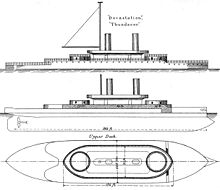
HMSThunderer (1872) represented the culmination of this pioneering piece of work. An ironclad turret ship designed by Edward James Reed, she was equipped with revolving turrets that used pioneering hydraulic turret machinery to maneouvre the guns. She was also the earth'south showtime mastless battleship, built with a fundamental superstructure layout, and became the prototype for all subsequent warships. With her sis HMSDevastation of 1871 she was some other pivotal design, and led directly to the mod battleship.

The US Navy tried to salve weight and deck space, and let the much faster firing 8-inch to shoot during the long reload time necessary for 12-inch guns by superposing secondary gun turrets direct on elevation of the primary turrets (as in the Kearsarge and Virginia-class battleships), but the idea proved to exist practically unworkable and was soon abandoned.[four]
With the advent of the South Carolina-class battleships in 1908, the main battery turrets were designed so every bit to superfire, to amend fire arcs on centerline mounted weapons. This was necessitated by a need to move all primary battery turrets to the vessel's centerline for improved structural back up. The 1906 HMSDreadnought, while revolutionary in many other ways, had retained fly turrets due to concerns well-nigh muzzle nail affecting the sighting mechanisms of a turret beneath. A similar advancement was in the Kongō-class battlecruisers and Queen Elizabeth-class battleships, which dispensed with the "Q" turret amidships in favour of heavier guns in fewer mountings.
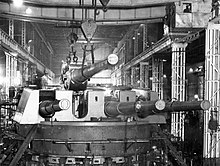
Like pre-dreadnoughts, the first dreadnoughts had two guns in each turret; notwithstanding, later ships began to be fitted with triple turrets. The first ship to be built with triple turrets was the Italian Dante Alighieri, although the first to be actually commissioned was the Austro-Hungarian SMSViribus Unitis of the Tegetthoff course. By the beginning of World War II, most battleships used triple or, occasionally, quadruple turrets, which reduced the full number of mountings and improved armour protection. However, quadruple turrets proved to be extremely circuitous to adapt, making them unwieldy in practice.

Bismarck 's secondary bombardment 15 cm gun turret
The largest warship turrets were in Globe State of war Ii battleships where a heavily armoured enclosure protected the large gun crew during boxing. The calibre of the main ammunition on big battleships was typically 300 to 460 mm (12 to 18 in). The turrets carrying three 460 mm guns of Yamato each weighed around ii,500 tonnes. The secondary armament of battleships (or the primary armament of light cruisers) was typically betwixt 127 and 152 mm (5.0 and 6.0 in). Smaller ships typically mounted guns from 76 mm (3.0 in) up, although these rarely required a turret mounting, except for large destroyers, similar the American Fletcher and the German Narvik classes.
Layout [edit]

Animation showing gun turret operation of the Stark I turret of the British BL 15 inch /42 naval gun. Compare the layout and nomenclature with the US design below.
In naval terms, turret traditionally and specifically refers to a gun mounting where the entire mass rotates as one, and has a trunk that projects below the deck. The rotating role of a turret seen above deck is the gunhouse, which protects the mechanism and crew, and is where the guns are loaded. The gunhouse is supported on a bed of rotating rollers, and is not necessarily physically attached to the ship at the base of the rotating structure. In the example of the German battleship Bismarck, the turrets were non vertically restrained and fell out when she sank. The British battlecruiser Hood, like some American battleships, did have vertical restraints.[19]
Below the gunhouse there may be a working bedchamber, where ammunition is handled, and the chief body, which accommodates the trounce and propellant hoists that bring ammunition upwards from the magazines below. There may be a combined hoist (cf the animated British turret) or divide hoists (cf the U.s.a. turret cutaway). The working bedroom and trunk rotate with the gunhouse, and sit down inside a protective armoured barbette. The barbette extends downward to the main armoured deck (crimson in the animation). At the base of the turret sit handing rooms, where shell and propelling charges are passed from the crush room and magazine to the hoists.
The treatment equipment and hoists are complex arrangements of machinery that ship the shells and charges from the magazine into the base of the turret. Bearing in listen that shells can weigh around a ton, the hoists have to exist powerful and rapid; a 15-inch turret of the type in the blitheness was expected to perform a complete loading and firing cycle in a minute.[20]

The loading arrangement is fitted with a serial of mechanical interlocks that ensure that there is never an open path from the gunhouse to the magazine downwardly which an explosive wink might pass. Wink-tight doors and scuttles open and shut to allow the passage between areas of the turret. Generally, with big-calibre guns, powered or assisted ramming is required to forcefulness the heavy shell and charge into the breech.
As the hoist and breech must be aligned for ramming to occur, there is by and large a restricted range of elevations at which the guns tin be loaded; the guns return to the loading tiptop, are loaded, so return to the target elevation, at which time they are said to be "in battery". The animation illustrates a turret where the rammer is fixed to the cradle that carries the guns, allowing loading to occur across a wider range of elevations.
Before turrets differed significantly in their operating principles. Information technology was non until the final of the "rotating drum" designs described in the previous section were phased out that the "hooded barbette" arrangement above became the standard.
Fly turrets [edit]

A wing turret is a gun turret mounted along the side, or the wings, of a warship, off the centerline.
The positioning of a wing turret limits the gun'due south arc of fire, so that it generally tin can contribute to only the broadside weight of fire on 1 side of the ship. This is the major weakness of wing turrets equally broadsides were the most prevalent type of gunnery duels. Depending on the configurations of ships, such as HMS Dreadnought just not SMSBlücher, the wing turrets could fire fore and aft, so this somewhat reduced the danger when an opponent crossed the T enabling information technology to burn down a full broadside.

Diagram of the battlecruiser Von der Tann, Brassey's Naval Annual 1913, showing wing turrets amidships.
Attempts were made to mountain turrets en echelon so that they could fire on either beam, such as the Invincible-class and SMSVon der Tann battlecruisers, but this tended to cause great impairment to the ships' deck from the muzzle nail.
Wing turrets were commonplace on upper-case letter ships and cruisers during the late 19th century up until the 1910s. In pre-dreadnought battleships, the wing turret contributed to the secondary battery of sub-calibre weapons. In big armoured cruisers, wing turrets contributed to the master battery, although the casemate mounting was more than common. At the fourth dimension, large numbers of smaller calibre guns contributing to the broadside were thought to be of keen value in demolishing a transport's upperworks and secondary armaments, every bit distances of boxing were limited by burn down control and weapon performance.

The pre-dreadnought battleship SMSRadetzky with two main gun turrets on centreline and four secondary on the sides
In the early 1900s, weapon performance, armour quality and vessel speeds generally increased along with the distances of engagement; the utility of large secondary batteries reducing every bit a upshot, and in addition at extreme range it was impossible to see the autumn of lesser weapons and then correct the aim. Therefore, most early dreadnought battleships featured "all big gun" armaments of identical calibre, typically 11 or 12 inches, some of which were mounted in wing turrets. This arrangement was not satisfactory, notwithstanding, equally the wing turrets not but had a reduced fire arc for broadsides, only besides because the weight of the guns put great strain on the hull and it was increasingly difficult to properly armour them.
Larger and subsequently dreadnought battleships carried superimposed or superfiring turrets (i.e. 1 turret mounted higher than and firing over those in forepart of and beneath it). This allowed all turrets to train on either beam, and increased the weight of fire forward and aft. The superfiring or superimposed system had not been proven until later South Carolina went to sea, and information technology was initially feared that the weakness of the previous Virginia-class ship's stacked turrets would repeat itself. Larger and later guns (such as the U.s.a. Navy's ultimate big gun design, the 16"/l Mark vii) besides could not be shipped in wing turrets, as the strain on the hull would have been too great.
Mod turrets [edit]

The GRP gunhouse is a mutual feature on modernistic naval gun turrets, this example existence on the frigate HMSNorthumberland.
Many modern surface warships accept mountings for big calibre guns, although the calibres are at present by and large between 3 and five inches (76 and 127 mm). The gunhouses are frequently just weatherproof covers for the gun mounting equipment and are fabricated of lite un-armoured materials such as glass-reinforced plastic. Modernistic turrets are ofttimes automatic in their operation, with no humans working within them and just a small squad passing fixed ammunition into the feed system. Smaller calibre weapons often operate on the autocannon principle, and indeed may not even be turrets at all; they may only exist bolted directly to the deck.
Turret identification [edit]
On board warships, each turret is given an identification. In the British Regal Navy, these would be messages: "A" and "B" were for the turrets from the front of the send backwards in forepart of the bridge, and letters nearly the end of the alphabet (i.e., "X", "Y", etc.) were for turrets behind the bridge ship, "Y" being the rearmost. Mountings in the middle of the ship would exist "P", "Q", "R", etc.[21] Confusingly, the Dido-class cruisers had a "Q" and the Nelson-class battleships had an "X" turret in what would logically be "C" position; the latter being mounted at the primary deck level in front of the bridge and behind the "B" turret, thus having restricted training fore and aft.[v]
Secondary turrets were named "P" and "South" (port and starboard) and numbered from fore to aft, e.g. P1 being the frontwards port turret.[ citation needed ]
In that location were exceptions; the battleship HMS Agincourt had the uniquely large number of seven turrets. These were numbered "1" to "vii" but were unofficially nicknamed "Sunday", Monday", etc. through to "Sabbatum".[ citation needed ]
In German language use, turrets were generally named "A", "B", "C", "D", "Due east", going from bow to stern. Usually the radio alphabet was used on naming the turrets (due east.g. "Anton", "Bruno" or "Berta", "Caesar", "Dora") as on the German battleship Bismarck.[ citation needed ]
In the United States Navy, main battery turrets are numbered fore to aft.[ citation needed ] Secondary gun mounts are numbered by gun cage bore in inches followed by a second digit indicating the position of the mountain, with the second digit increasing fore to aft. Gun mounts non on the centerline would be assigned odd numbers on the port side and even numbers on the starboard side. For example, "Mount 52" would be the forwardmost 5-inch gun mount on the starboard side of the ship.
Aircraft [edit]
History [edit]
During World War I, air gunners initially operated guns that were mounted on pedestals or swivel mounts known every bit pintles. The latter evolved into the Scarff ring, a rotating ring mount which allowed the gun to exist turned to any direction with the gunner remaining straight behind it, the weapon held in an intermediate height past bungee cord, a simple and effective mounting for unmarried weapons such as the Lewis Gun though less handy when twin mounted as with the British Bristol F.2 Fighter and German "CL"-class two-seaters such as the Halberstadt and Hannover-designed serial of compact two-seat combat aircraft. In a failed 1916 experiment, a variant of the SPAD S.A two-seat fighter was probably the first aircraft to exist fitted with a remotely-controlled gun, which was located in a nose nacelle.
Equally shipping flew higher and faster, the need for protection from the elements led to the enclosure or shielding of the gun positions, as in the "lobsterback" rear seat of the Hawker Demon biplane fighter.

The first British operational bomber to carry an enclosed, power-operated turret was the British Boulton & Paul Overstrand twin-engined biplane, which first flew in 1933. The Overstrand was similar to its Outset World War predecessors in that it had open cockpits and paw-operated defensive automobile guns.[22] Notwithstanding, dissimilar its predecessors, the Sidestrand could fly at 140 mph (225 km/h) making operating the exposed gun positions hard, particularly in the aircraft's nose. To overcome this problem, the Overstrand was fitted with an enclosed and powered nose turret, mounting a single Lewis gun. As such the Overstrand was the kickoff British aircraft to have a power-operated turret. Rotation was handled by pneumatic motors while tiptop and depression of the gun used hydraulic rams. The pilot's cockpit was likewise enclosed but the dorsal (upper) and ventral (abdomen) gun positions remained open, though shielded.[23]

A Martin YB-10 service test bomber with the USAAC - the outset flight of the B-ten pattern occurred in mid-February 1932.
The Martin B-10 all-metal monocoque monoplane bomber introduced turret-mounted defensive armament within the United States Ground forces Air Corps, almost simultaneously with the RAF's Overstrand biplane bomber pattern. The Martin XB-ten prototype aircraft offset featured the nose turret in June 1932—roughly a year earlier the less advanced Overstrand airframe design—and was first produced as the YB-ten service exam version past November 1933. The production B-10B version started service with the USAAC in July 1935.
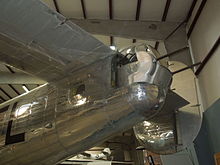
A B-24 Liberator rear turret.
In fourth dimension the number of turrets carried and the number of guns mounted increased. RAF heavy bombers of World War II such as the Handley Page Halifax (until its Mk Two Series I (Special) version omitted the olfactory organ turret), Short Stirling and Avro Lancaster typically had 3 powered turrets: rear, mid-upper and olfactory organ. (Early in the war, some British heavy bombers likewise featured a retractable, remotely-operated ventral (or mid-under) turret). The rear turret mounted the heaviest armament: four 0.303 inch Browning machine guns or, late in the war, two AN/M2 light-barrel versions of the US Browning M2 automobile gun as in the Rose-Rice turret. The tail gunner or "Tail Stop Charlie" position was generally accepted to be the most dangerous consignment.[ commendation needed ]
During the World War II era, British turrets were largely cocky-contained units, manufactured by Boulton Paul Aircraft and Nash & Thompson. The same model of turret might be fitted to several different aircraft types. Some models included gun-laying radar that could lead the target and compensate for bullet driblet.
As almost a 1930s "updated" adaptation of the earlier Bristol F.2'southward concept, the Britain introduced the concept of the "turret fighter", with aeroplanes such as the Boulton Paul Defiant and Blackburn Roc where the armament (iv 0.303 inch) machineguns was in a turret mounted behind the airplane pilot, rather than in stock-still positions in the wings. The Defiant and Roc possessed no fixed, forrard-firing automatic ordnance; the World War I-era Bristol F.2 was designed with i synchronized Vickers auto gun firing forward on a fuselage mount.
The concept came at a time when the standard armament of a fighter was only 2 car guns and in the face up of heavily armed bombers operating in germination, it was thought that a group of turret fighters would be able to concentrate their fire flexibly on the bombers; making beam, stern and rising attacks practicable. Although the thought had some merits in attacking unescorted bombers the weight and elevate penalty of the turret (and gunner) put them at a disadvantage when Frg was able to escort its bombers with fighters from bases in Northern France. By this point British fighters were flying with viii machine guns which full-bodied firepower for use in single fleeting attacks of fighters against bombers.
Attempts to put this heavier ammunition, such as multiple 20 mm cannon in depression contour aerodynamic turrets were explored by the British but were not successful, this class of weapons and heavier armament (up to and including artillery pieces as in the ane,420 examples produced of the American B-25G and B-25H Mitchell medium bombers, and the experimental 'Tsetse' variant of the de Haviland Mosquito) being exclusively fuselage or underwing-mounted and thus aimed past pointing the aircraft every bit a whole.
Non all turret designs put the gunner in the turret along with the armament: United states and German-designed aircraft both featured remote-controlled turrets.

A B-17'southward Bendix mentum turret, remotely controlled by the bombardier.
In the U.s.a., the large, purpose-built Northrop P-61 Black Widow night fighter was produced with a remotely operated dorsal turret that had a wide range of fire though in exercise it was generally fired straight forward under control of the pilot. For the last Douglas-built product blocks of the B-17F (the "B-17F-xx-DL" designated blocks), and for all versions of the B-17G Flying Fortress a twin-gun remotely operated "mentum" turret, designed by Bendix and commencement used on the experimental YB-40 "gunship" version of the Fortress, was added to requite more forrad defense. Specifically designed to be compact and not obstruct the bombardier, this was operated by a swing-abroad diagonal column possessing a yoke[24] to traverse the turret, and aimed by a reflector sight mounted in the windscreen.

One of the FDSL 131 remote gun turrets of a Messerschmitt Me 210 being maintained, with cover removed.
The intended replacement for the German Bf 110 heavy fighter, the Messerschmitt Me 210, possessed twin half-teardrop-shaped, remotely operated Ferngerichtete Drehringseitenlafette FDSL 131/1B turrets, one on each side "flank" of the rear fuselage to defend the rear of the shipping, controlled from the rear area of the cockpit. Past 1942, the High german He 177A Greif heavy bomber would feature a Fernbedienbare Drehlafette FDL 131Z remotely operated forward dorsal turret, armed with twin 13mm MG 131 car guns on the elevation of the fuselage, which was operated from a hemispherical, clear rotating "astrodome" just behind the cockpit glazing and offset to starboard atop the fuselage—a second, manned powered Hydraulische Drehlafette HDL 131 dorsal turret, further aft on the fuselage with a unmarried MG 131 was likewise used on nearly examples.
The US B-29 Superfortress had 4 remote controlled turrets, comprising two dorsal and two ventral turrets. These were controlled from a trio of hemispherically glazed gunner-manned "astrodome" sighting stations operated from the pressurised sections in the nose and middle of the shipping, each housing an altazimuth mounted pivoting gunsight to aim one or more than of the unmanned remote turrets as needed, in addition to a B-17 manner flexible manned tail gunner'southward station.
The defensive turret on bombers vicious from favour with the realization that bombers could non attempt heavily defended targets without escort regardless of their defensive armament unless very high loss rates were acceptable, and the performance penalisation from the weight and elevate of turrets reduced speed, range and payload and increased the number of crew required. The already mentioned British de Havilland Mosquito calorie-free bomber was designed to operate without any defensive armament and used its speed to avoid engagement with fighters, much as the minimally armed German Schnellbomber aircraft concepts had been meant to do early in World War Ii.
A minor number of aircraft continued to use turrets however—in item maritime patrol aircraft such as the Avro Shackleton used one as an offensive weapon against modest unarmoured surface targets. The Boeing B-52 jet bomber and many of its contemporaries (particularly Russian) featured a barbette (a British English language term equivalent to the American usage of the term 'tail gun'), or a "remote turret"—an unmanned turret but often ane with a more limited field of burn down than a manned equivalent.
Layout [edit]
Aircraft comport their turrets in various locations:
- "dorsal" – on top of the fuselage, sometimes referred to every bit a mid-upper turret.
- "ventral" – underneath the fuselage, often on US heavy bombers, a Sperry-designed ball turret.
- "rear" or "tail" – at the very end of the fuselage.
- "olfactory organ" – at the front of the fuselage.
- "cheek" – on the flanks of the nose, as single-gun flexible defensive mounts for B-17 and B-24 heavy bombers
- "mentum" – beneath the nose of the aircraft every bit on after versions of the Boeing B-17 Flying Fortress.
- "fly" – a handful of very large aircraft, such as the Messerschmitt Me 323 and the Blohm & Voss BV 222, had manned turrets in the wings
- "waist" or "axle" – mounted on the sides of the rear fuselage e.g. U.s.a. twin- and iv-engined bombers.
Gallery [edit]
-

-
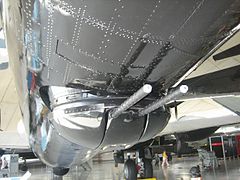
B-29 remote controlled aft ventral turret
-

Fly turrets of an Me 323
-
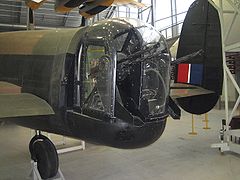
-

Combat vehicles [edit]
History [edit]
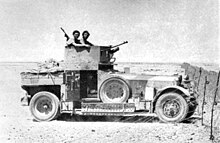
Among the first armoured vehicles to be equipped with a gun turret were the Lanchester and Rolls-Royce Armoured Cars, both produced from 1914. The Royal Naval Air Service (RNAS) raised the commencement British armoured car squadron during the First Globe War.[25] In September 1914 all available Rolls Royce Argent Ghost chassis were requisitioned to form the basis for the new armoured automobile. The following month a special committee of the Admiralty Air Department, among whom was Flight Commander T.One thousand. Hetherington, designed the superstructure which consisted of armoured bodywork and a single fully rotating turret holding a regular h2o cooled Vickers auto gun.
Notwithstanding, the beginning tracked combat vehicles were not equipped with turrets due to the problems with getting sufficient trench crossing while keeping the middle of gravity low, and it was not until late in Globe War I that the French Renault FT low-cal tank introduced the single fully rotating turret conveying the vehicle'due south primary armament that continues to exist the standard of nigh every modern principal boxing tank and many post-Earth War Ii self-propelled guns. The starting time turret designed for the FT was a circular, bandage steel version almost identical to that of the epitome. It was designed to bear a Hotchkiss 8mm machine gun. Meanwhile, the Berliet Company produced a new blueprint, a polygonal turret of riveted plate, which was simpler to produce than the early cast steel turret. It was given the proper noun "omnibus", since it could easily be adapted to mount either the Hotchkiss car gun or the Puteaux 37mm with its telescopic sight. This turret was fitted to production models in large numbers.
In the 1930s, several nations produced multi-turreted tanks—probably influenced by the experimental British Vickers A1E1 Independent of 1926. Those that saw combat during the early role of Globe War Two performed poorly and the concept was soon dropped. Gainsay vehicles without turrets, with the main ammunition mounted in the hull, or more often in a completely enclosed, integral armored casemate equally function of the main hull, saw extensive employ by both the German (as Sturmgeschütz and Jagdpanzer vehicles) and Soviet (every bit Samokhodnaya Ustanovka vehicles) armored forces during Earth War II as tank destroyers and assault guns. However, post-state of war, the concept roughshod out of favour due to its limitations, with the Swedish Stridsvagn 103 'S-Tank' and the German Kanonenjagdpanzer being exceptions.
Layout [edit]
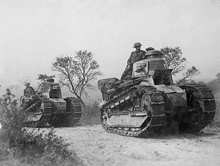
US Army tank troops with Renault FTs on the Western Forepart, 1918. The FT was the first operational tank to conduct a turret.
In modern tanks, the turret is armoured for coiffure protection and rotates a full 360 degrees carrying a single large-calibre tank gun, typically in the range of 105 mm to 125 mm calibre. Auto guns may be mounted inside the turret, which on modern tanks is ofttimes on a "coaxial" mount, parallel with the larger main gun.
Early designs often featured multiple weapons mounts. This concept was carried forwards into the early on interwar years in U.k., Deutschland and the Soviet Union, arguably reaching its most absurd expression in the British Vickers A1E1 Independent tank, though this attempt was shortly abandoned while the Soviet Union'south similar endeavor produced a 'land battleship' which was actually produced and fought in defence of the Soviet Union.
In modernistic tanks, the turret houses all the coiffure except the driver (who is located in the hull). The crew located in the turret typically consist of tank commander, gunner, and oftentimes a gun loader (except in tanks that have an autoloader), while the driver sits in a separate compartment with a dedicated entry and exit, though oft one that allows the driver to leave via the turret basket (fighting compartment).
For other combat vehicles, the turrets are equipped with other weapons dependent on role. An infantry fighting vehicle may carry a smaller calibre gun or an autocannon, or an anti-tank missile launcher, or a combination of weapons. A mod self-propelled gun mounts a large artillery gun just less armour. Lighter vehicles may carry a one-human being turret with a unmarried automobile gun, occasionally the same model being shared with other classes of vehicle, such as the Cadillac Gage T50 turret/weapons station.
The size of the turret is a gene in gainsay vehicle design. I dimension mentioned in terms of turret design is "turret band diameter" which is the size of the aperture in the top of the chassis into which the turret is seated.
State fortifications [edit]
In 1859, the Royal Committee on the Defence of the United Kingdom were in the process of recommending a huge programme of fortifications to protect U.k.'s naval bases. They interviewed Captain Coles, who had bombarded Russian fortifications during the Crimean War, still Coles repeatedly lost his temper during the word and the commissioners failed to ask him nearly the gun turret that he had patented before in that year, with the result that none of the Palmerston Forts mounted turrets.[26] Somewhen, the Admiralty Pier Turret at Dover was commissioned in 1877 and completed in 1882.
In continental Europe, the invention of high explosive shells in 1885 threatened to make all existing fortifications obsolete; a partial solution was the protection of fortress guns in armoured turrets. Pioneering designs were produced by Commandant Henri-Louis-Philippe Mougin in French republic and Captain Maximilian Schumann in Germany. Mougin's designs were incorporated in a new generation of polygonal forts constructed by Raymond Adolphe Séré de Rivières in French republic and Henri Alexis Brialmont in Belgium. Adult versions of Schumann'south turrets were employed afterwards his death in the fortifications of Metz.[27] In 1914, the Brialmont forts in the Battle of Liège proved unequal to the High german "Large Bertha" 42 cm siege howitzers, which were able to penetrate the turret armour and smash turret mountings.[28]

Elsewhere, armoured turrets, sometimes described a cupolas, were incorporated into coastal arms defences. An extreme example was Fort Drum, the "concrete battleship", near Corregidor, Philippines; this mounted 4 huge 14-inch guns in two naval pattern turrets and was the only permanent turreted fort ever constructed by the United States.[29] Between the wars, improved turrets formed the offensive ammunition of the Maginot Line forts in France. During the Second World War, some of the artillery pieces in the Atlantic Wall fortifications, such equally the Cantankerous-Channel guns, were large naval guns housed in turrets.
Some nations, from Albania to Switzerland and Austria, have embedded the turrets of obsolete tanks in physical bunkers, while others have constructed or updated fortifications with modern artillery systems, such as the 1970s era Swedish coastal artillery battery on Landsort Isle.
Gallery [edit]
-
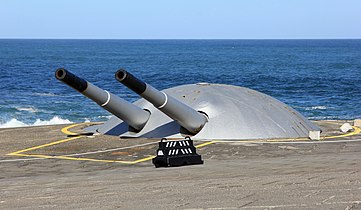
A German built 190 mm gun turret at Fort Copacabana in Brazil, completed in 1914.
-
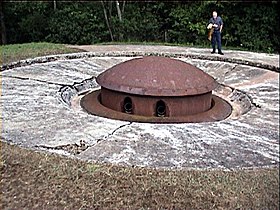
Turret of the Maginot Line; this could retract into the ground when not firing, for added protection.
-
A twin 305 mm gun turret at Kuivasaari, Finland, completed in 1935.
-
12 cm tornautomatpjäs m/lxx adult to defend vital points like seaports from enemy landing ships, equally well as area denial and fire support, fifty-fifty on a nuclear battlefield.
Come across also [edit]
- Barbette
- Casemate
- Director (military)
- Gun wagon
- Gun mount
- Gun shield
- Rangefinder
- Remote weapon system
- Sponson
Footnotes [edit]
- ^ a b In architecture, a cupola is a small, most often dome-like, structure on top of a building, and then although it is often used to describe a sub-turret such equally commander's sub-turret on a tank turret, if a gun turret is mounted on a vessel or in a higher place a bunker and is dome shaped information technology too may be referred to as a cupola in some sources.
- ^ See box bombardment and fundamental battery ship
- ^ Ericsson later on admitted that this was a serious flaw in the ship's design and that the pilot house should accept been placed atop the turret.
- ^ Something similar occurred in American armoured vehicle designs around the time of the Second Globe War, tanks sprouting 'superfiring' turrets including the M3 Lee and M60A2 Patton. Given they were generally intended for an already-overburdened commander to operate, they have largely been abandoned in favour of literally lower-profile arrangements for protected observation with, in some cases, top-mounted remotely-operated weapons.
- ^ The Nelson design was an adaption of an before planned battleship with two turrets before the span and a single one behind the bridge but in front of the aft superstructure.
References [edit]
- ^ "Turret n." Online Etymology Dictionary . Retrieved 21 February 2019.
- ^ Davis, William C. (9 May 2012). Duel Between the First Ironclads. Knopf Doubleday Publishing Group. ISBN9780307817501 . Retrieved 29 May 2017 – via Google Books.
- ^ Preston, Antony (2002). The Earth's Worst Warships . London: Conway Maritime Press. p. 21. ISBN978-0-85177-754-ii.
- ^ a b c K. C. Barnaby (1968). Some ship disasters and their causes. London: Hutchinson. pp. 20–30.
- ^ Grand. C. Barnaby (1968). Some transport disasters and their causes. London: Hutchinson. pp. 28–29.
- ^ Stanley Sandler (2004). Battleships: An Illustrated History of Their Impact. ABC-CLIO. pp. 27–33. ISBN9781851094103.
- ^ Tucker, Spencer (2006). Blue & gray navies: the Civil War afloat. Maryland: Naval Institute Press. p. 171. ISBN978-i-59114-882-1.
- ^ a b c d e Thompson, Stephen C. (1990). "The Pattern and Construction of the USS Monitor". Warship International. Toledo, Ohio: International Naval Inquiry Organization. XXVII (3). ISSN 0043-0374.
- ^ Mindell, David A. (2000). State of war, Engineering, and Experience Aboard the USS Monitor. Johns Hopkins Academy Press. p. 41. ISBN978-0-8018-6250-2.
- ^ McCordock, Robert Stanley (1938). The Yankee Cheese Box. Dorrance. p. 31.
- ^ Baxter, James Phinney, 3rd (1968). The Introduction of the Ironclad Warship (reprint of the 1933 publication ed.). Hamden, Connecticut: Archon Books. p. 256. OCLC 695838727.
- ^ Canney, Donald L. (1993). The Old Steam Navy. Vol. 2: The Ironclads, 1842–1885. Annapolis, Maryland: Naval Institute Press. pp. 79–80. ISBN978-0-87021-586-v.
- ^ Reed, Sir Edward James (1869). Our Atomic number 26-clad Ships: Their Qualities, Performances, and Price. With Chapters on Turret Ships, Iron-clad Rams. London: J. Murray. pp. 253–54.
- ^ Broadwater, John D. (2012). USS Monitor: A Historic Transport Completes Its Final Voyage. Texas A&K University Press. p. 8. ISBN978-1-60344-473-vi.
- ^ Wilson, H. W. (1896). Ironclads in Activeness: A Sketch of Naval Warfare From 1855 to 1895. Vol. 1. Boston: Little, Brown. p. thirty.
- ^ Field, Ron (2011). Amalgamated Ironclad vs Matrimony Ironclad: Hampton Roads. Osprey Publishing. p. 33. ISBN978-1-78096-141-5.
- ^ Olmstead, Edwin; Stark, Wayne E.; Tucker, Spencer C. (1997). The Big Guns: Civil War Siege, Seacoast, and Naval Cannon. Alexandria Bay, New York: Museum Restoration Service. p. 90. ISBN978-0-88855-012-v.
- ^ Lyon, David & Winfield, Rif The Sheet and Steam Navy List, all the ships of the Imperial Navy 1815-1889, pub Chatham, 2004, ISBN i-86176-032-9 pp. 240–42
- ^ Jurens, William; Garzke Jr, William H; Dulin Jr, Robert O; Roberts, John; Fiske, Richard, A Marine Forensic Analysis of HMS Hood and DKM Bismarck, p. 14, CiteSeerX10.ane.1.202.317
- ^ Capt. S. W. Roskill, RN, HMS Warspite, Classics of Naval Literature, Naval Institute Press, 1997 ISBN 1-55750-719-viii
- ^ Keegan, John (1989). The Cost of Admiralty . New York: Viking. p. 281. ISBN978-0-670-81416-9.
- ^ Claus Reuter, Evolution of Aircraft Turrets in the AAF, 1917–1944, Scarborough, Ont., German language Canadian Museum of Applied History, 2000 p. 11.
- ^ The Overstrand's Turret Flight 1936
- ^ "Graphic of usage and stowage positions for B-17G mentum turret control yoke". www.lonesentry.com.
- ^ First World War. Willmott, H.P., Dorling Kindersley, 2003, p. 59
- ^ Crick, Timothy (2012) Ramparts of Empire: The Fortifications of Sir William Jervois, Majestic Engineer 1821–1897, Academy of Exeter Printing, ISBN 978-1-905816-04-0. pp. 46–47
- ^ Donnell, Clayton, Breaking the Fortress Line 1914, Pen & Sword Military, ISBN 978-1848848139. pp. viii–thirteen
- ^ Hogg, Ian Five (1975), Fortress: A History of Armed services Defense force, Macdonald and Jane's, ISBN 0-356-08122-ii. pp. 118–xix
- ^ Hogg. p. 116
Bibliography [edit]
- Brown, J. (1977). "RCT Armament in the Boeing B-29". Air Enthusiast. No. 3. pp. fourscore–83. ISSN 0143-5450.
External links [edit]
-
 Media related to Gun turrets at Wikimedia Commons
Media related to Gun turrets at Wikimedia Commons - Air Gunnery Archived 2014-01-11 at the Wayback Car Nov 1943 Pop Science article on aircraft turrets
- Flight article on aircraft gun turrets amongst others
- Lone Sentry'southward Bendix B-17 chin turret transmission and details
How To Clear A 240 Turret Controller Malfunction,
Source: https://en.wikipedia.org/wiki/Gun_turret
Posted by: tarverfrose1966.blogspot.com

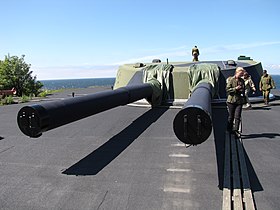
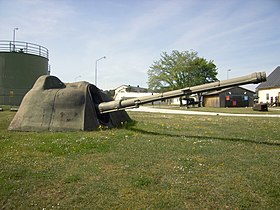

0 Response to "How To Clear A 240 Turret Controller Malfunction"
Post a Comment